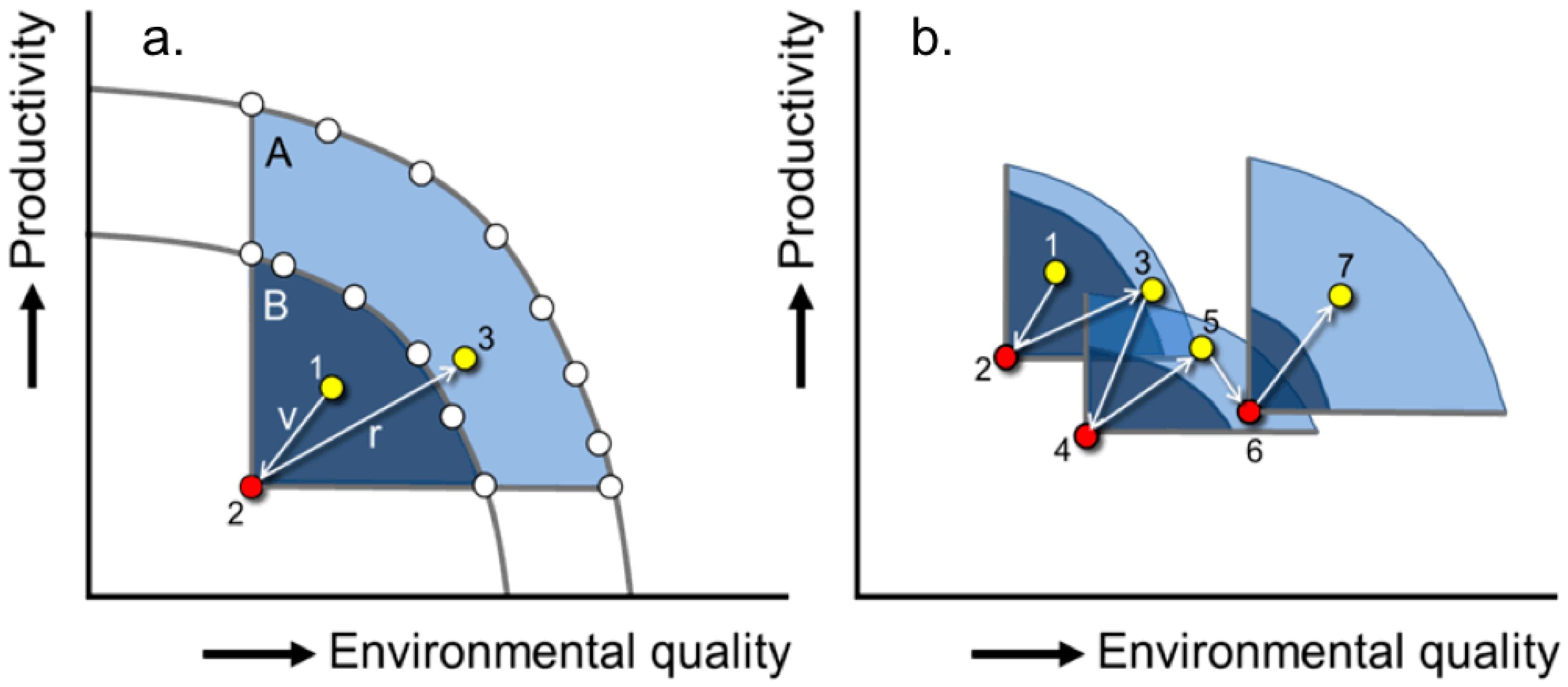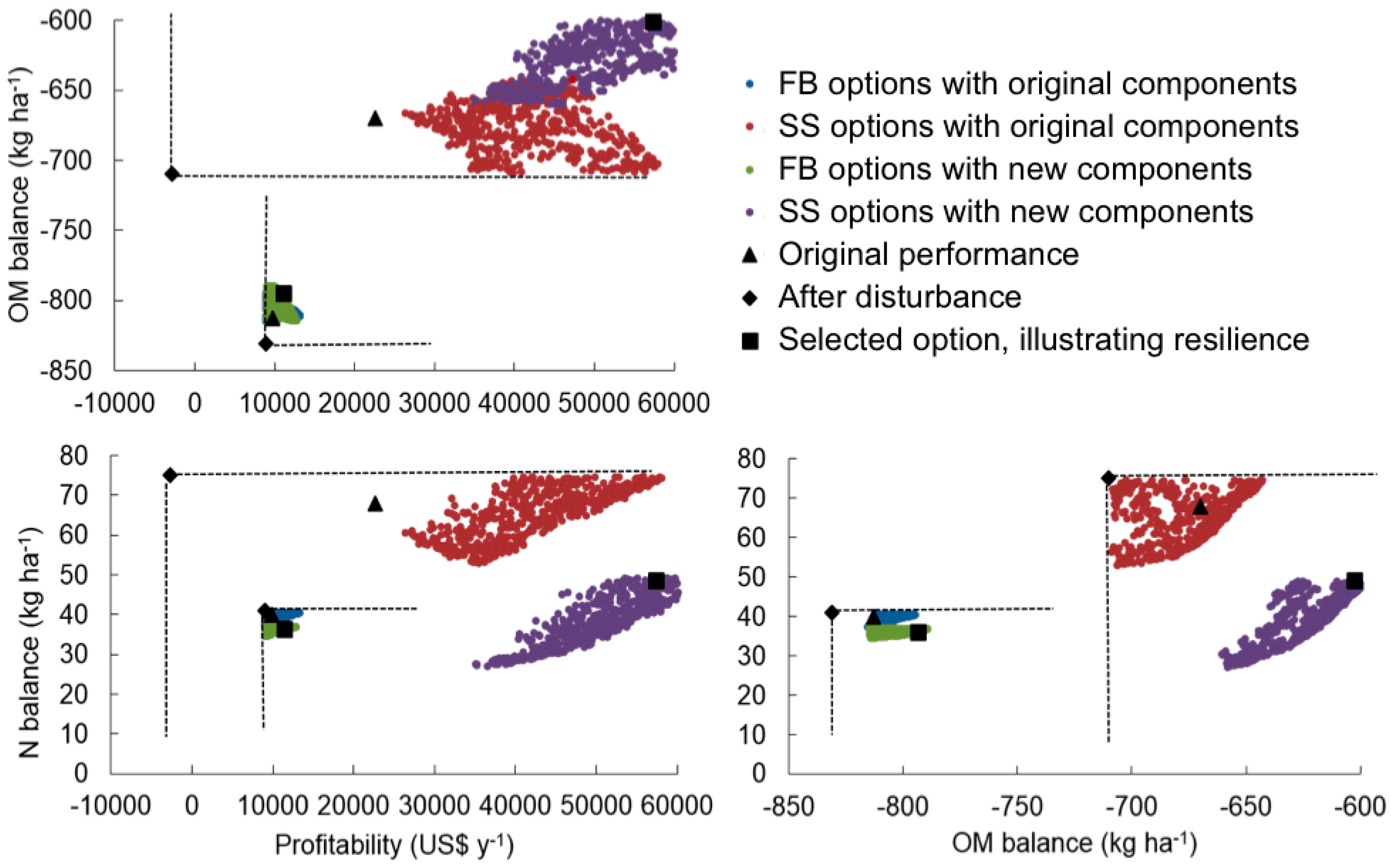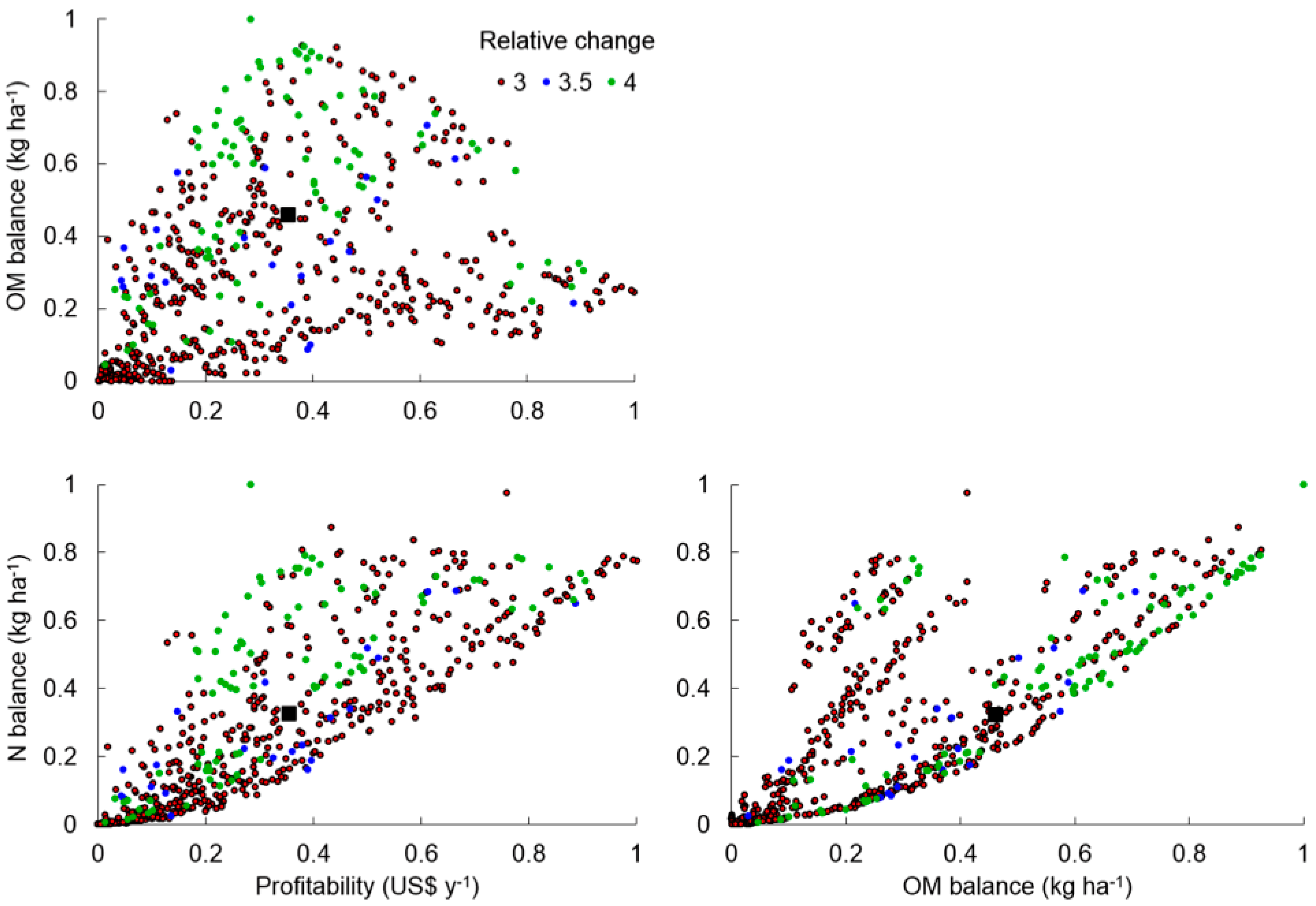Capturing Agroecosystem Vulnerability and Resilience
Abstract
:1. Introduction
2. Conceptual Approach
3. Materials and Methods
3.1. Regional Characterization
3.2. Dairy Farm Characterization
3.3. Vulnerability and Resilience Assessment
- C = relative change index
- n = number of decision variables
- xp,q = value of decision variable p for alternative q from the set of solutions
- xp,min = minimum value of decision variable p
- xp,max = maximum value of decision variable p
4. Results
4.1. Vulnerability
4.2. Buffer Capacity and Adaptive Capacity
4.3. Required Changes in Farm Management
4.4. Resilience
5. Discussion
6. Conclusions
Supplementary Materials
Acknowledgments
Author Contributions
Conflicts of Interest
References
- Meinke, H.; Howden, S.M.; Struik, P.C.; Nelson, R.; Rodriguez, D.; Chapman, S.C. Adaptation science for agriculture and natural resource management—Urgency and theoretical basis. Curr. Opin. Environ. Sustain. 2009, 1, 69–76. [Google Scholar] [CrossRef]
- Gornall, J.; Betts, R.; Burke, E.; Clark, R.; Camp, J.; Willett, K.; Wiltshire, A. Implications of climate change for agricultural productivity in the early twenty-first century. Philos. Trans. R. Soc. Lond. B Biol. Sci. 2010, 365, 2973–2989. [Google Scholar] [CrossRef] [PubMed]
- Herrero, M.; Thornton, P.K.; Notenbaert, A.M.; Wood, S.; Msangi, S.; Freeman, H.A.; Bossio, D.; Dixon, J.; Peters, M.; van de Steeg, J.; et al. Smart investments in sustainable food production: Revisiting mixed crop-livestock systems. Science 2010, 327, 822–825. [Google Scholar] [CrossRef] [PubMed]
- Suweis, S.; Carr, J.A.; Maritan, A.; Rinaldo, A.; D’Odorico, P. Resilience and reactivity of global food security. Proc. Natl. Acad. Sci. USA 2015, 112, 6902–6907. [Google Scholar] [CrossRef] [PubMed]
- Adger, W.N. Vulnerability. Glob. Environ. Chang. 2006, 16, 268–281. [Google Scholar] [CrossRef]
- Miller, F.; Osbahr, H.; Boyd, E.; Thomalla, F.; Bharwani, S.; Ziervogel, G.; Walker, B.; Birkmann, J.; Van der Leeuw, S.; Rockström, J.; et al. Resilience and vulnerability: Complementary or conflicting concepts? Ecol. Soc. 2010, 15, 1–25. [Google Scholar]
- Walker, B.H.; Abel, N.; Anderies, J.M.; Ryan, P. Resilience, adaptability, and transformability in the Goulburn-Broken catchment, Australia. Ecol. Soc. 2009, 14, 12. [Google Scholar]
- Gitz, V.; Meybeck, A. Risks, Vulnerabilities and Resilience in a Context of Climate Change. Available online: http://www.fao.org/docrep/017/i3084e/i3084e03.pdf (accessed on 9 September 2015).
- Gunderson, L.; Holling, C.S. Panarchy: Understanding Transformations in Human and Natural Systems; Island Press: Washington, DC, USA, 2001. [Google Scholar]
- Brand, F.S.; Jax, K. Focusing the Meaning(s) of Resilience: Resilience as a Descriptive Concept and a Boundary Object. Ecol. Soc. 2007, 12, 23. [Google Scholar] [CrossRef]
- Darnhofer, I.; Fairweather, J.; Moller, H. Assessing a farm´s sustainability: Insights from resilience thinking. Int. J. Agric. Sustuain. 2010, 8, 186–198. [Google Scholar] [CrossRef]
- Luers, A.L.; Lobell, D.B.; Sklar, L.C.; Addams, C.L.; Matson, P.A. A method for quantifying vulnerability, applied to the agricultural system of the Yaqui Valley, Mexico. Glob. Environ. Chang. 2003, 13, 255–267. [Google Scholar] [CrossRef]
- Speranza, C.I. Buffer capacity: Capturing a dimension of resilience to climate change in African smallholder agriculture. Reg. Environ. Chang. 2013, 13, 521–535. [Google Scholar] [CrossRef]
- Luers, A.L. The surface of vulnerability: An analytical framework for examining environmental change. Glob. Environ. Chang. 2005, 15, 214–223. [Google Scholar] [CrossRef]
- Eakin, H.; Benessaiah, K.; Barrera, J.F.; Cruz-Bello, G.M.; Morales, H. Livelihoods and landscapes at the threshold of change: Disaster and resilience in a Chiapas coffee community. Reg. Environ. Chang. 2012, 12, 475–488. [Google Scholar] [CrossRef]
- Tittonell, P. Livelihood strategies, resilience and transformability in African agroecosystems. Agric. Syst. 2014, 126, 3–14. [Google Scholar] [CrossRef]
- Darnhofer, I.; Moller, H.; Fairweather, J. Farm Resilience for Sustainable Food Production: A Conceptual Framework; Working Paper; Lincoln University: Christchurch, New Zealand, 2008. [Google Scholar]
- Scheffer, M.; Carpenter, S.; Foley, J.A.; Folke, C.; Walker, B. Catastrophic shifts in ecosystems. Nature 2001, 413, 591–596. [Google Scholar] [CrossRef] [PubMed]
- Carpenter, S.; Walker, B.; Anderies, J.M.; Abel, N. From metaphor to measurement: Resilience of what to what? Ecosystems 2001, 4, 765–781. [Google Scholar] [CrossRef]
- Beisner, B.E.; Haydon, D.T.; Cuddington, K. Alternative stable states in ecology. Front. Ecol. Environ. 2003, 1, 376–382. [Google Scholar] [CrossRef]
- Suding, K.N.; Gross, K.L.; Houseman, G.R. Alternative states and positive feedbacks in restoration ecology. Trends Ecol. Evol. 2004, 19, 46–53. [Google Scholar] [CrossRef] [PubMed]
- Folke, C.; Carpenter, S.; Walker, B.; Scheffer, M.; Elmqvist, T.; Gunderson, L.; Holling, C.S. Regime Shifts, Resilience, and Biodiversity in Ecosystem Management. Annu. Rev. Ecol. Evol. Syst. 2004, 35, 557–581. [Google Scholar] [CrossRef]
- Scheffer, M.; Brock, W.; Westley, F. Socioeconomic mechanisms preventing optimum use of ecosystem services: An interdisciplinary theoretical analysis. Ecosystems 2000, 3, 451–471. [Google Scholar] [CrossRef]
- Anderies, J.M.; Janssen, M.A.; Ostrom, E. A framework to analyze the robustness of social-ecological systems from an institutional perspective. Ecol. Soc. 2004, 9, 18. [Google Scholar] [CrossRef]
- Shah, G.A.; Groot, J.C.J.; Shah, G.M.; Lantinga, E.A. Simulation of Long-Term Carbon and Nitrogen Dynamics in Grassland-Based Dairy Farming Systems to Evaluate Mitigation Strategies for Nutrient Losses. PLoS ONE 2013, 8, e67279. [Google Scholar] [CrossRef] [PubMed]
- Groot, J.C.J.; Rossing, W.A.H.; Lantinga, E.A.; Van Keulen, H. Exploring the potential for improved internal nutrient cycling in dairy farming systems, using an eco-mathematical model. NJAS Wagening. J. Life Sci. 2003, 51, 165–194. [Google Scholar] [CrossRef]
- Power, B.; Rodriguez, D.; DeVoil, P.; Harris, G.; Payero, J. A multi-field bio-economic model of irrigated grain-cotton farming systems. Field Crops Res. 2011, 124, 171–179. [Google Scholar] [CrossRef]
- Janssen, S.; Van Ittersum, M.K. Assessing farm innovations and responses to policies: A review of bio-economic farm models. Agric. Syst. 2007, 94, 622–636. [Google Scholar] [CrossRef]
- Holling, C.S. Resilience of ecosystems; local surprise and global change. In Sustainable Development of the Biosphere; Clark, W.C., Munn, R.E., Eds.; Cambridge University Press: Cambridge, UK, 1986; pp. 292–317. [Google Scholar]
- Holling, C.S. Understanding the complexity of economic, ecological and social systems. Ecosystems 2001, 4, 390–405. [Google Scholar] [CrossRef]
- Milestad, R.; Darnhofer, I. Building farm resilience: The prospects and challenges of organic farming. J. Sustain. Agric. 2003, 22, 81–97. [Google Scholar] [CrossRef]
- Walker, B.; Gunderson, L.; Kinzig, A.; Folke, C.; Carpenter, S.; Schultz, L. A handful of heuristics and some propositions for understanding resilience in social-ecological systems. Ecol. Soc. 2006, 11, 13. [Google Scholar] [CrossRef]
- Groot, J.C.J.; Rossing, W.A.H. Model-aided learning for adaptive management of natural resources: An evolutionary design perspective. Methods Ecol. Evol. 2011, 2, 643–650. [Google Scholar] [CrossRef]
- Auger, A.; Bader, J.; Brockhoff, D.; Zitzler, E. Hypervolume-based multiobjective optimization: Theoretical foundations and practical implications. Theor. Comput. Sci. 2012, 425, 75–103. [Google Scholar] [CrossRef]
- De Gobierno, S.H. Ayuntamiento Constitucional de Marcos Castellanos: Plan de Desarrollo Municipal. Available online: https://issuu.com/simarsureste/docs/plan_municipal_de_desarrollo_marcos (accessed on 14 November 2016).
- Cortez-Arriola, J.; Groot, J.C.J.; Améndola Massiotti, R.D.; Scholberg, J.M.S.; Mariscal Aguayo, V.D.; Tittonell, P.; Rossing, W.A.H. Resource use efficiency and farm productivity gaps of smallholder dairy farming in North-west Michoacán, Mexico. Agric. Syst. 2014, 126, 15–24. [Google Scholar] [CrossRef]
- Cortez-Arriola, J.; Rossing, W.A.H.; Améndola Massiotti, R.D.; Scholberg, J.M.S.; Groot, J.C.J.; Tittonell, P. Leverages for on-farm innovation from farm typologies? An illustration for family-based dairy farms in north-west Michoacán, Mexico. Agric. Syst. 2015, 135, 66–76. [Google Scholar] [CrossRef]
- Cortez-Arriola, J.; Groot, J.C.J.; Rossing, W.A.H.; Scholberg, J.M.S.; Améndola Massiotti, R.D.; Tittonell, P. Alternative options for sustainable intensification of smallholder dairy farms in North-West Michoacán, Mexico. Agric. Syst. 2016, 144, 22–32. [Google Scholar] [CrossRef]
- Groot, J.C.J.; Oomen, G.J.M.; Rossing, W.A.H. Multi-objective optimization and design of farming systems. Agric. Syst. 2012, 110, 63–77. [Google Scholar] [CrossRef]
- Lizárraga, G.; Aguayo, A.; Garza, T.; Peñuñuri, F. Comparación de la producción de forraje de ballico italiano (Lolium multiflorum Lam) y cebada forrajera (Hordeum vulgare L.) solos y asociados. Técnica Pecuaria México 1980, 39, 17–24. [Google Scholar]
- Abson, D.J.; Fraser, E.D.; Benton, T.G. Landscape diversity and the resilience of agricultural returns: A portfolio analysis of land-use patterns and economic returns from lowland agriculture. Agric. Food Secur. 2013. [Google Scholar] [CrossRef]
- Brzezina, N.; Kopainsky, B.; Mathijs, E. Can Organic Farming Reduce Vulnerabilities and Enhance the Resilience of the European Food System? A Critical Assessment Using System Dynamics Structural Thinking Tools. Sustainability 2016, 8, 971. [Google Scholar] [CrossRef]
- Xu, L.; Marinova, D.; Guo, X. Resilience thinking: A renewed system approach for sustainability science. Sustain. Sci. 2015, 10, 123–138. [Google Scholar] [CrossRef]
- Schippers, P.; van der Heide, C.M.; Koelewijn, H.P.; Schouten, M.A.H.; Smulders, R.M.J.M.; Cobben, M.M.P.; Sterk, M.; Vos, C.C.; Verboom, J. Landscape diversity enhances the resilience of populations, ecosystems and local economy in rural areas. Landsc. Ecol. 2014, 30, 193–202. [Google Scholar] [CrossRef]



| Variable | FB | SS | ||||
|---|---|---|---|---|---|---|
| Profit | OM Balance | N Balance | Profit | OM Balance | N Balance | |
| Condition assessed | ||||||
| Original values | 9712 | −813 | 40 | 22,557 | −670 | 68 |
| After perturbation | 8865 | −831 | 41 | −2800 | −710 | 75 |
| Selected configuration | 11,169 | −795 | 37 | 57,398 | −601 | 49 |
| Variables estimated | ||||||
| Vulnerability (v) | 847 | 18 | 1 | 25,357 | 40 | 7 |
| Recovery (r) | 2304 | 36 | 4 | 60,198 | 109 | 26 |
| Resilience (R = r/v) | 2.7 | 2.0 | 4.0 | 2.4 | 2.7 | 3.7 |
© 2016 by the authors; licensee MDPI, Basel, Switzerland. This article is an open access article distributed under the terms and conditions of the Creative Commons Attribution (CC-BY) license (http://creativecommons.org/licenses/by/4.0/).
Share and Cite
Groot, J.C.J.; Cortez-Arriola, J.; Rossing, W.A.H.; Améndola Massiotti, R.D.; Tittonell, P. Capturing Agroecosystem Vulnerability and Resilience. Sustainability 2016, 8, 1206. https://doi.org/10.3390/su8111206
Groot JCJ, Cortez-Arriola J, Rossing WAH, Améndola Massiotti RD, Tittonell P. Capturing Agroecosystem Vulnerability and Resilience. Sustainability. 2016; 8(11):1206. https://doi.org/10.3390/su8111206
Chicago/Turabian StyleGroot, Jeroen C. J., José Cortez-Arriola, Walter A. H. Rossing, Ricardo D. Améndola Massiotti, and Pablo Tittonell. 2016. "Capturing Agroecosystem Vulnerability and Resilience" Sustainability 8, no. 11: 1206. https://doi.org/10.3390/su8111206
APA StyleGroot, J. C. J., Cortez-Arriola, J., Rossing, W. A. H., Améndola Massiotti, R. D., & Tittonell, P. (2016). Capturing Agroecosystem Vulnerability and Resilience. Sustainability, 8(11), 1206. https://doi.org/10.3390/su8111206






